
Explainer | China’s low inflation set to be ‘long-term phenomenon’: 4 takeaways from March’s data
- China’s consumer price index (CPI) grew by 0.1 per cent in March year on year, although analysts said it was still ‘trending upwards’
- Producer price index (PPI) fell for the 18th month in a row, dropping by 2.8 per cent in March from a year earlier
1. Risk of deflation remains as CPI drops
The CPI index had marked a first rise in six months in February, having expanded by 0.7 per cent.
“China’s CPI inflation dropped to 0.1 per cent from 0.7 per cent last month. This indicates that China still faces the risk of deflation, as domestic demand remains weak,” said Zhang Zhiwei, president and chief economist at Pinpoint Asset Management.
Analysts at Capital Economics said while CPI inflation rose less than expected in March, it was still “trending upwards”.
“We think an easing of food price deflation and the ongoing modest economic recovery will support a slow reflation in the near term. But persistent oversupply will likely keep inflation low, with CPI inflation to average only 0.5 per cent over the next couple of years,” they said.
Capital Economics said the main drivers in March were an easing of food price deflation from minus 3.4 per cent year on year to minus 2.7 per cent, and a pickup in energy price inflation from 0.3 per cent to 0.4 per cent.
China consumer inflation remains low, fuelling policy shift calls
“While the larger-than-expected decline is likely to stir discussion of deflation once again, it should be noted that non-food inflation remained solidly in positive territory at 0.7 per year on year,” said Lynn Song, chief economist for Greater China at ING.
He pointed to a larger-than-expected moderation of non-food inflation as the reason for the CPI reading falling short of expectations.
Analysts at HSBC pointed to a pullback in pork prices and consumption demand following the Lunar New Year holiday, as well as a relatively higher base from more reopening tailwinds at the same time last year.
2. Factory-gate prices fall for 18th straight month
China’s producer price index – which measures the cost of goods at the factory gate – declined for the 18th straight month in March after falling by 2.8 per cent year on year, compared to a fall of 2.7 per cent in February.
“Rapid investment in manufacturing capacity is still weighing on factory-gate prices,” said analysts at Capital Economics.
Prices dropped by 0.1 per cent in month-on-month terms, they added, with the biggest declines in energy and metal prices.
3. Core inflation disappoints
China’s core inflation, which excludes volatile food and energy prices, grew by 0.6 per cent year on year in March, compared to 1.2 per cent growth in February and 0.4 per cent expansion in January.
“Disappointingly, core CPI inflation fell back below 1 per cent to 0.6 per cent year on year in March, or a contraction of 0.6 per cent month on month,” said analysts at HSBC.
A higher relative base, a fading of consumer demand following the Lunar New Year holiday and a contraction of tourism and overall entertainment prices contributed to the decline, they added.
4. China ‘not stuck in a deflationary spiral’
Analysts at Capital Economics expect the CPI reading to remain below pre-pandemic norms for the foreseeable future, while they expect PPI inflation to remain in negative territory.
“The [central bank] appears somewhat concerned about low inflation as their recent quarterly meeting committed to promoting a mild rise in prices,” they said.
“But with the exchange rate under pressure, their appetite for substantial monetary easing still seems limited.
“In any case, with policymakers directing credit to the supply side of the economy, policy support is unlikely to resolve the investment-consumption imbalance behind China’s low inflation, which we think will be a long-term phenomenon.”
To sustain the positive momentum we have been seeing in other economic indicators, policymakers will need to keep a proactive stance
Song at ING said that low inflation provides ample room for policy easing, but concerns over stability of the yuan may limit room for rate cuts in near term.
“While we believe that data will gradually show that China is not stuck in a deflationary spiral, nonetheless inflation remains well below target, and looking at economic fundamentals alone, we think the economy would benefit from further rate cuts,” he added.
Analysts at HSBC expect CPI inflation to average at 0.7 per cent this year, saying the setback in China’s CPI is likely to be temporary.
“Nonetheless, to sustain the positive momentum we have been seeing in other economic indicators, policymakers will need to keep a proactive stance,” they added.

.JPG?itok=J8tgfPmW&v=1659948715)